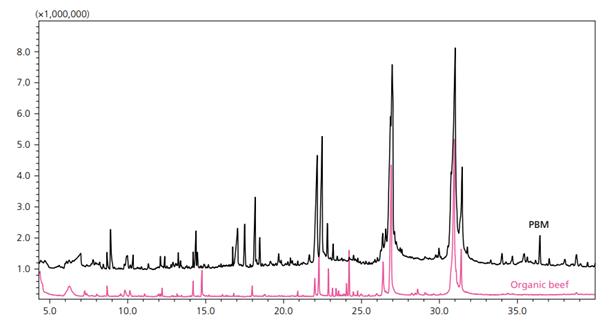
Panel discussion on...
Healthy lifestyle
Welcome in the world of alternative meat: analytical challenges and perspectives

Introduction
1) Over the past year, there has been a solidifying of the new consumer perspectives regarding health and wellness, which initially surfaced during the COVID-19 pandemic. Multifunctionality has been the keyword as individuals increasingly view health in a more comprehensive manner. This holistic approach is evident across various dietary supplements, especially those addressing overlapping lifestyle needs such as mental health, sleep, digestion, beauty, immunity, inflammation, energy and weight management (1).
In this regard, a great scientific achievement in nutritional sciences in the last twelve months could arguably be attributed to advancements in the understanding of collagen’s potential for overall health and well-being. Collagen-based applications have shown promise in positively influencing various aspects of health, including sleep quality and gastrointestinal comfort (2, 3). This represents a significant step forward in the development of nutrition solutions tailored to meet the demands of today's consumers' lifestyles.
What’s remarkable about natural foods with multifunctional properties is that they often have a positive domino effect on the body - and researchers are only beginning to explore this topic’s complexity. For example, there is growing interest in how addressing gut issues through nutritional solutions could impact emotional well-being in the long run. I believe that by integrating our medical knowledge with a more holistic understanding of nutrition and health, we can enhance the quality of life of many individuals.
7a) A common trait worldwide is people’s desire to uphold fitness and vitality throughout their later years, leading them to actively seek ways to enhance their health even in the absence of specific symptoms. This stems from an increasing awareness of the body as an ecosystem, recognizing the benefits of an active lifestyle on various aspects of health. According to statistics from FMCG Gurus, over 70% of consumers globally rate their health as good, yet they remain committed to improving it (4). Digestion, mental well-being, immunity, and sleep quality emerge as primary areas where consumers express a keen interest in improvement (5).
7b) Differently from Western countries, in Asia, for instance, holistic medicine and traditional, nature-inspired healing practices have deep roots in many of the region’s cultures. Consequently, because the entire human body is traditionally viewed as a holistic entity, the connection between emotional well-being and gut health is already known and well-accepted. It is, however, very exciting to see that scientists are now investigating the mechanisms behind this connection.
8a) I see lifestyle apps as a valuable, complementary tool for supplement brands rather than competitors to them. After all, big developments in science are always driven by technology. From genome sequencing to high-performance computing, the interplay between cutting-edge research and evolving technologies has continuously fueled scientific breakthroughs. Today, digital tools offer substantial opportunities. For example, nutrition researchers need to analyze the impact of a supplement on an individual’s overall health – a complex process. Artificial intelligence (AI) approaches offer new opportunities for better predicting and understanding the complex processes behind the benefits of multifunctional supplements. Also, thanks to personal devices and apps, it is possible to monitor how individuals respond to specific foods, facilitating the development of products suited to a personalized approach to nutrition.
8d) As a science-driven company, at Rousselot, we’re actually using digital apps to uncover both the efficacy and efficiency of food products thanks to the combination of clinical trials with real-world evidence. For example, we recently partnered with specialists to develop a convenient, user-friendly mobile app, ”Ingredients for Life,” to study the potential of our hydrolyzed cartilage matrix (HCM) as a joint health supplement and demonstrate how digitally-enabled protocols can create more realistic and inclusive clinical study designs, that complement standardized clinical trials. The app helped us recruit a wider and more heterogeneous cohort study – in terms of age, gender and activity level – in a more cost-effective way than traditional methods. It also encouraged participants to stick to the weekly questionnaire in the long run, demonstrating that mobile apps can generate qualitative, quantifiable, real-world data showcasing supplement effectiveness.
9d) In nutritional science, as in many other fields, the integration of big data and AI is set to revolutionize the landscape. So yes, I firmly believe that by 2030, our industry will leverage data alongside AI to conduct accurate simulations even before testing in a clinical setting. Of course, today we already predict in very generic terms, it’s what preventative solutions are built on. But as simulation increasingly emerges as a viable avenue for research, the potential arises for us to predict the efficacy of particular collagen formulations in aiding specific demographics with certain conditions. While the extent of this advancement remains uncertain, technological progress undoubtedly opens doors to previously inaccessible realms of research, enabling exploration into the health advantages of collagen tailored to distinct demographic subsets such as age groups, health statuses, lifestyles, or physical build. In addition, this will accelerate the innovation cycle, facilitating the rapid emergence of further insights.
10a) Yes, sustainability has definitely emerged as a significant concern within the nutraceutical industry. With growing awareness of environmental issues, consumers are increasingly scrutinizing the origins of their supplements. Therefore, brands that are transparent about their production processes are best positioned to gain their trust. The interest in upcycled ingredients is also on the rise (6). Collagen, for example, as a natural and safe protein, aligns with this movement towards reducing food waste and promoting a circular economy. As part of Darling Ingredients, it is in our DNA to transform nutrient-rich raw materials into high-quality, functional solutions, making sure none of their natural goodness goes to waste.
What is required to scale-up production of alternative protein sources, such as lab-grown meat and cultivated (breast/bovine) milk?
For the production of 1 kg meat approx. 1 thousand times more water is needed than for 1 kg grain. And furthermore 60% of grain production in Germany is used for feeding cattle and pork.
The development of automated production equipment for tailor-made cultured meat using 3D bioprinting will help to feed the world (4).
The 3D bioprinting technology was developed by Professor Matsusaki of the Osaka University to create muscle tissue structures. This technology is expected to be utilized in the field of food, for production of cultured meat with controlled arrangement of muscle, fat, and blood vessels.
Most of the cultured meats reported so far have a minced structure consisting only of muscle cells, making it difficult to reproduce complex structures. To solve this problem, Matsusaki and co-workers developed a 3D bioprinting technology that uses 3D printing to produce different fibrous tissues (muscle, fat, and blood vessels) and integrates them into a bundle. This technology has made it possible not only to reproduce the famous Wagyu beef, but also to delicately adjust the fat and muscle components. Osaka University and Shimadzu will jointly develop equipment to automate the production of cultured meat using this technology. (5).
What are the most effective methods for enhancing the flavor and texture of alternative proteins?There are meaningful reasons not to go for these new types of foods
Bad experience in terms of taste and texture
Raw meat on its own has little aroma; therefore, almost all aromas associated with “meatiness” are created during the cooking process by the Maillard Reaction between amino acids and reducing sugars. That reaction determines which non-volatile precursors release volatile aroma compounds. Plant-based meat (PBM), products created to resemble animal meat in both look and taste, are growing in popularity. A plant protein such as soy protein concentrate, along with colors, stabilizers, and oils, is used to successfully mimic meat flavor and texture. And, just like in animal meat, the amino acids of that protein undergo the Maillard Reaction.
Samples of PBM were run with the solid phase microextraction GC-MS and the volatile profile was compared against that of the organic beef. Similar compounds, such as fatty acids and Maillard browning reaction products, were found in both types of meat (Figure 1).
The differences can be explained by the different and wide variety of precursors present in PBM since it contains amino acids and sugars from various sources as opposed to regular meat.
There are five basic tastes, including deliciousness, which are perceived by people. The amount and kind of amino acids contribute to taste components. Of all the amino acids, glutamic acid is widely known as a component of the delicious taste. Further, the types and component ratios of amino acids largely control the flavor of food products. For example, glycine and alanine are associated with sweetness, valine and leucine with bitterness, and aspartic acid and glutamic acid with deliciousness.
The texture of food, including the sense of crispness, springiness, firmness, and the feeling on the tongue, is an important element that together with taste has an impact on the deliciousness of food. Food texture is normally evaluated using sensory tests. However, sensory tests are often difficult to reproduce, due to individual differences in people’s sensations and physical condition.
A texture analyzer can support sensory test with objective results in the form of numerical values for use in the field of food development. The texture analyzer evaluates the texture characteristics and allows a comparison of the texture of plant-based meat (PBM) and, for instance, chicken meatballs. Compared to chicken-derived products, plant-based meatballs had a higher force under loading conditions with less elasticity, which is the property to restore deformation (6). It is consistent with the result of the sensory test.

Figure 1. Overlaid Representative Chromatograms for PBM (black) and Organic Beef (pink) (6).
Panelists
References and notes
- Euromonitor International, The Five Trends Pushing Global Consumer Health into 2024. Article available here: https://www.euromonitor.com/article/the-five-trends-pushing-global-consumer-health-into-2024
- Thomas et al., submitted for publication.
- Taylor, G., et al., “The effects of collagen peptides on exercise-induced gastrointestinal stress: a randomized, controlled trial”, Eur J Nutr., 2023, 62(2): p. 1027-1039. https://link.springer.com/article/10.1007/s00394-022-03051-2
- FMCG Gurus, Consumer Perceptions on Health and Wellness, 21st February 2023. Article available here: https://fmcggurus.com/blog/fmcg-gurus-consumer-perceptions-on-health-and-wellness/#:~:text=Attitudes%20to%20Health&text=Digestion%2C%20mental%20well%2Dbeing%2C,of%20health%20and%20well%2Dbeing
- FMCG Gurus, ibid.
- Mintel’s 2024 Global Food and Drink Trends
Questions
1.
2.
3.
4.
5.
How have consumer awareness & demands related to healthy lifestyle changed in the last 12 months?
Where do you see the greatest scientific achievement in nutritional sciences in the last 12 months?
Are there specific health benefit areas in which significant more clinical studies are being done than in others, comparing the last 3 years?
What are the key influencers driving consumer purchasing decision for supplements or health foods? Is substantiation of claims important?
How do consumer today judge their health status?
Please put the following parameter in order 1 highest priority 7 lowest priority:
- Physical Symptoms, like pain, fatigue, constipation, weight gain
- Fitness Levels: endurance, strength, flexibility,
- Health Tracking Devices and heart rate, sleep patterns, steps taken
- Diet and Nutrition: intake of fruits, vegetables, whole grains, proteins.
- Mental and Emotional Well-being: stress levels, emotional balance, happiness
- Quality of sleep: Sleep quality and duration
- Medical Check-ups: blood pressure checks, cholesterol screenings, blood sugar tests
6.
Delivery formats can support consumer compliance and underline the technology driven approach of the brand.
a.
b.
c.
Do you see a consumer trend in preferences for certain delivery formats?
Are delivery format preference a regional, cultural aspect like taste?
Do you see a trend to carry out ingredient clinical trials using a selected delivery format as study product formulation or are most clinical studies still done in capsules?
7.
Consumer health concerns can vary widely across different regions and demographics globally. However, several common health concerns tend to be prevalent across various countries and populations due to globalization, lifestyle changes, environmental factors, and access to information.
a.
b.
Which are the key global consumer health concerns?
Do you see regional differences?
8.
There is a significant increase in the availability of apps and digital platforms focused on healthy lifestyle, particularly to support personalized approaches to mental wellbeing, metabolic support, weight management and physical fitness.
a.
b.
c.
d.
Do you see lifestyle apps as competition for supplement brands?
Do you think that these apps help to educate consumers, being more targeted when searching for supplements?
Did you consider setting up a lifestyle app to promote your supplement or your ingredient?
Did you set up a lifestyle app to promote your supplement/ ingredient and can you explore about your experience and business impact?
9.
AI (Artificial Intelligence) algorithms are today offered for various aspects of clinical trials to proof efficacy of your health ingredient or supplement.
a.
b.
c.
d.
Are consumers looking for substantiation of claims through AI driven clinical trials?
Did you consider working with an CRO specialist in AI to investigate your health ingredient or supplement?
If you applied already AI methods during the discovers/ development of your health ingredient, please share your experience and recommendation with us.
Do you think that in 2030 AI will be a manifest tool for clinical trials?
10.
A healthy lifestyle may also involve a commitment to sustainable practices for both personal and planetary health. This could include supporting ethical and environmentally conscious products.
a.
b.
c.
d.
e.
Do you agree that sustainability has become a growing concern also in the nutraceutical industry?
Are consumer looking proactively for brands which have ethical and environmental principles?
Are you looking for ethically sourced raw materials, ingredients?
Did you implement measures to establish resource-efficient processes?
Are you developing socially useful products and how do you define it?
11.
What are the major geographical differences related to healthy lifestyle trends?
a.
b.
c.
d.
e.
What are the latest trends related to claims and product forms in China?
In the U.S.
In Mexico
How are claims and dosage forms differentiated in Europe? How does your company ensure compliance with health and safety regulations in Europe?
Do you have a country where you would like to speak about trends for products?
12.
Focus clinical studies. Overall, there has been a recognized push for more gender-inclusive, geographical, and target group focused clinical research. The same trend can be seen in clinical trials for supplements or functional foods.
a.
b.
c.
d.
Please select an area you are active in and let us know which is your hot topic ingredients for 2024 for this area, based on substantiated claim, parameters, biomarkers being studied and/ or clinical study being done. Please name ingredients by scientific name and composition and not by brand name.
Please select your geographical area:
Western (EU, USA)
Asia (China, Japan, Asia Pacific)
Americas (Middle and Latin America)
Kids development/ early life nutrition/infant in Western countries and AP
Adult nutrition and prevention of developing disease
Elderly nutrition and how to support quality of life during aging
Sports nutrition, within different life decades and activity levels
References and notes























